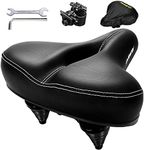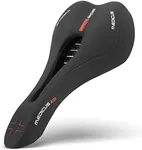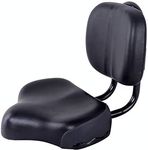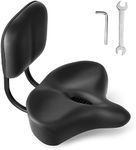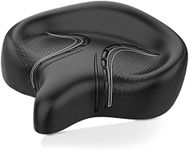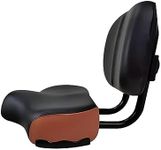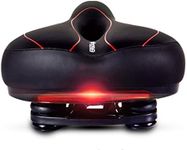Buying Guide for the Best Most Comfortable Bike Seats
Choosing the right bike seat is crucial for ensuring a comfortable and enjoyable ride. The right seat can make a significant difference in your cycling experience, whether you're commuting, touring, or mountain biking. When selecting a bike seat, consider factors such as your riding style, the distance you typically travel, and your personal comfort preferences. It's important to remember that comfort is subjective, so what works for one person may not work for another. Testing different seats and paying attention to how your body feels during and after rides can help you find the best fit for you.Seat WidthSeat width is the measurement across the widest part of the seat. It's important because it needs to support your sit bones properly. A seat that's too narrow can cause discomfort and pressure, while one that's too wide can lead to chafing. Generally, wider seats are better for upright riding positions, like those on cruiser bikes, while narrower seats are suited for more aggressive, forward-leaning positions, like those on road bikes. To choose the right width, consider your riding style and measure the distance between your sit bones to ensure the seat provides adequate support.
PaddingPadding in a bike seat provides cushioning and can significantly affect comfort. It is usually made from foam or gel. Foam padding is firmer and provides support for longer rides, while gel padding is softer and offers immediate comfort, making it ideal for short rides. If you ride long distances, a firmer seat with less padding might be more comfortable as it provides better support over time. For casual or short rides, a seat with more padding might be preferable. Consider how long and how often you ride to determine the right amount of padding for you.
Seat ShapeThe shape of a bike seat can influence comfort and performance. Seats can be flat, contoured, or have a cut-out design. Flat seats are versatile and can suit various riding styles, while contoured seats provide more support and can help with stability. Seats with a cut-out or channel are designed to relieve pressure on sensitive areas, which can be beneficial for long rides. Your choice should depend on your riding style and any specific comfort needs you have. If you experience numbness or discomfort, a seat with a cut-out might be worth considering.
MaterialThe material of a bike seat affects its durability, comfort, and appearance. Common materials include synthetic leather, real leather, and fabric. Synthetic materials are durable, weather-resistant, and often more affordable, making them a good choice for all-weather riders. Real leather seats can be more comfortable over time as they mold to your shape, but they require more maintenance. Fabric seats can offer a softer feel and are often used in more casual or urban bike seats. Consider the conditions you ride in and how much maintenance you're willing to do when choosing the material.
RailsRails are the bars under the seat that attach it to the bike. They can be made from steel, aluminum, titanium, or carbon fiber. Steel rails are strong and affordable but heavier. Aluminum is lighter and offers a good balance of strength and weight. Titanium and carbon fiber rails are the lightest and provide some shock absorption, but they are more expensive. If weight is a concern, such as in competitive cycling, lighter materials might be preferable. For everyday use, steel or aluminum rails are often sufficient and more cost-effective.
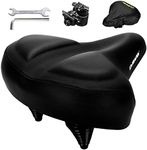
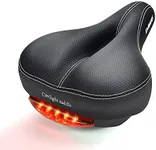
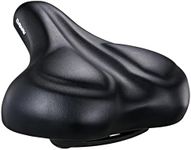
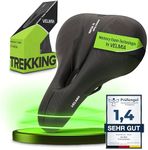
![Wittkop Bike Seat [City] Bicycle Ex](https://images-proxy.bestreviews.guide/OLjda7m6KKup50yy25nSFxchMK4=/0x150/https://m.media-amazon.com/images/I/41jhwYZN6DL._AC_CX679_.jpg)
